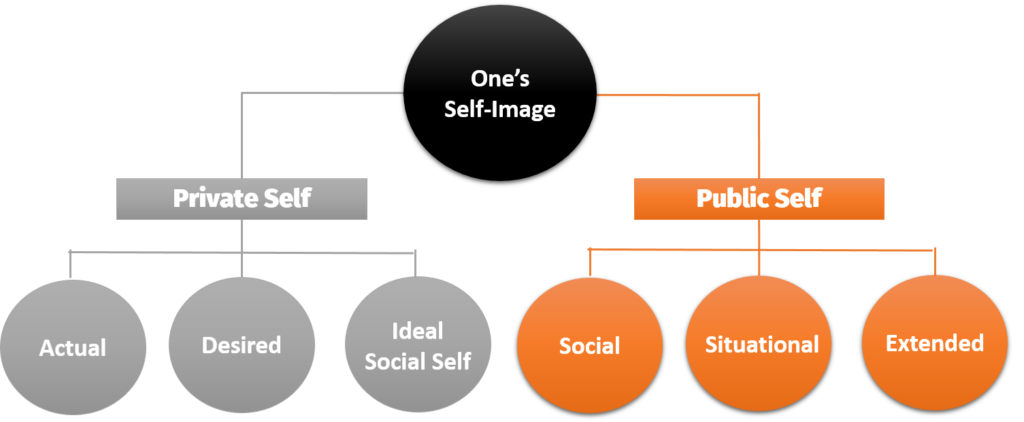My friend, I find it beautiful how complex human behaviour can be.
For example, we do not behave consistently as one same person, permanently with same motivations. Depending on the situation and perspective, we can be many. And we tend to have a clear sense, notion or concepts of each these versions of ourselves, which are named: self-concepts (defined by Rosenberg in 1979 as “the sum total of our thoughts, feelings and imagination as to who we are”).
And who are we? Well, there is much than meets the eye when it comes to our sense of self. There are many versions of our selves. Our behavior is much more complex than it may seem.
Throughout time, researchers have come up with several classifications of self-concepts. In fact, the literature can be quite contradictory in terms of the classifications of the different selves. So to facilitate for you, I will describe here six different types: actual-self, ideal-self, ideal social-self, social-self, situational-self and extended-self.
(Although other classifications may include, for example: possible selves, expressive selves, negative selves, online selves and, trust me, many more!). But let’s stick to those 6, ok? And those 6 types we can classify in two groups: private-self (related to how we view ourselves) and the public-self (our evaluations of how others perceives us).
Here is a beautiful figure I made of each self, while listening to “Ave Maria” by Bach, so you can have an overview:

Private-Self
The private-self is composed of three main personas: the actual, the ideal and the ideal-social self.
The actual self (also often called “real self”, “basic self” or simply, “self”) is the person we believe we truly are. The actual self describes the perception we have of our true selves. We all know who we are, what we stand for, our morals, our desires and what we enjoy. We all are aware what makes us feel like ourselves. This is what the actual-self is.
Nevertheless, in our minds we often have an image or projection of an individual we would like to or aspire to be. This is the ideal-self (also called “desired” self or “idealized” self). Very often we purchase things or undergo an immense expense simply to live for a brief moment our ideal-self. Perhaps traveling is a great example of it.
Finally, in our thoughts we also have an idea of how we would like others to see us. This is the ideal-social self (also often named “desired social self”). This is an important type of self from a marketing perspective, as a great deal of our our consumption behaviors and choice for brands are based on what brands can communicate to others about ourselves. After all, brands also have personalities.
Public-Self
Different to the private-self, the public-self refers to our perceptions of how others perceive us. And here I would like to explain three types: the social-self, situational-self and extended–self.
The social-self (described also as the “looking glass self” or “presenting self”) represents the image we believe others have of us. Which, obviously, is sometimes very different from our actual-self.So our perceptions of social-self is important because we often use it to moderate our behaviors. For example, if we think our social-self image is not very positive or professional, we may dress differently, mention important topics and keep our voices low in work environments or when meeting the parents of our partners for the first time. This way, we hope to influence positively our social-self.
The situational-self is the persona we portray in specific situations, and as some authors claim, it is the result of a variety of self-images that one has. For example, are we who we are during carnival? I am certainly not. During carnival I dance to songs I would never dance otherwise, I talk to strangers more naturally, I dress weird costumes and potentially (I said “potentially”!) have a few more drinks than I normally should.
Finally, the extended-self represents the way that impressions are made about me based on my material possessions. Imagine for a minute that someone you do know could enter your bedroom. Simply by looking at the material possessions you have (e.g. pictures on the walls, books, style of furniture, clothes), what could they know about you? The material things we posses can communicate a great deal of who we are.
Discovering Our Selves
And how do we know what or whom is our “self”? Well, something that will certainly help is to travel.
In 2018, Hajo Adam and some of his colleagues published a super interesting paper titled “The shortest path to oneself leads around the world: Living abroad increases self-concept clarity” (pretty good title for a paper, right?). Through a combination of methods and a sample of over 1,800 participants they identified that traveling induces self-reflections that contribute immensely to the understanding of who we are, clarifying the notion of our self.
I could not agree more with the findings. As I write this, I am 39 years old, have lived in 5 countries and traveled to more than 25 (which I hope this lit keeps on growing!). And all of these experiences have been so important for my understanding of who I am and who I would like others to see me.

Source: Pexels.com
Almost a century before in 1919, the German author Hermann von Keyserling wrote in his celebrated book “The travel diary of a philosopher” the famous quote: “’The shortest path to oneself leads around the world.”
Well, he could not be more right.
And What do the Different “Selves” Have to do Our Consumption Behaviors?
Well, here is an important insight for you: each different self is usually a different consumer, as each one has different purchase motivations.
And guess what? You and I are exactly like that too. Let me give you example:
Imagine for a second you are strolling down a hall on a shopping mall, slowly staring at store windows as you walk along. What is going through your mind when you see those products? Well, consciously or unconsciously, we conduct mental calculations regarding how each product (e.g. leather jacket, button shirt, fancy watches, sneakers) and the personality of their brands suits our different selves and meets their needs and wants.
Now assume you are done shopping and is walking down the parking lot back to your car holding store bags in your hands. What do you have? Well, some of those purchases may be for your actual-self (pair of jeans and black t-shirts). Some, for your situational-self (a carnival costume or a shirt for a party). Others, for your social-self (leather shoes for work). So you see how interesting this is? All those products are so contrastingly different because each self has different needs and motivations.
At the same time, they are all part of who you are. Beautiful, right?
Self-Concept, Consumption and Satisfaction
But how satisfied would you be with each purchase? You see, during product evaluations, what consumers are seeking is something we call self-image congruence (or congruity). Self-image congruence is a term coined to explain the perfect match between the personality or image of a brand or products (and everything it represents and can communicate), with style of the self we are buying it for. So you can have reach, for example, actual self-congruity, ideal self-congruity, social self-congruity and so on.
Pretty interesting, right?
For example, my actual-self (who I think I am) is basic, rough/outdoor and masculine. So unconsciously, I am inclined to purchase brands and products that have a “rugged” personality (outdoorsy, rough, masculine). It’s embarrassing, but when drying my clothes after washing I always notice the incredible amount of black clothes I have (yes, even socks!).
These are choices I make almost unconsciously. Because of who I think I am, I am naturally driven to brands and products that have similar profile. On the other hand, my social-self at work, often wears suits and ties (academia in Germany can be formal at times), as it is maybe appropriate for colleague and students here in Germany to see this way.
Furthermore, the link between brand personality and self-expression is not a one-way relationship (from brand to the individual). Rather, it is a two-way street (from the individual to the brand as well). In particular, when consumers prefer a certain brand personality dimension (e.g. ruggedness, sophistication, competence, sincerity and excitement), they tend to have a preferred brand of choice (meaning they know exactly what they want).
Final Thoughts
So yeah, as I mentioned at the start, I find human behavior to be beautifully complex. In many ways we are actors, displaying different characters in the theater of life (yes my friend, I can also be a bit philosophical).
And to finish up, in case you would like to know more about self-concept, the one author I would certainly suggest is M. Joseph Sirgy, a Professor of Marketing at Virginia Tech. His main paper, “Self–concept in consumer behavior: A critical review” has become a classic.





